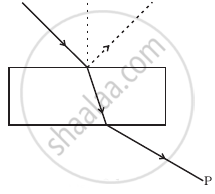Advertisements
Advertisements
प्रश्न
What does a polaroid consist of? How does it produce a linearly polarised light?
उत्तर
A polaroid consists of long-chain molecules aligned in a particular direction. The electric vectors (associated with the propagating light wave) along the direction of the aligned molecules get absorbed. Thus, if an unpolarised light wave is incident on such a polaroid, then the light wave will get linearly polarised with the electric vector oscillating along a direction perpendicular to the aligned molecule.
APPEARS IN
संबंधित प्रश्न
What dose a polaroid consist of?
Show, using a simple polaroid, that light waves are transverse in nature. Intensity of light coming out of a polaroid does not change irrespective of the orientation of the pass axis of the polaroid. Explain why.
The refractive indices of glass and water w.r.t. air are 3/2 and 4/3 respectively. Determine the refractive index of glass w.r.t. water.
What is the Brewster angle for air to glass transition? (Refractive index of glass = 1.5)
State two uses of Polaroid.
What is a analyser?
State and obtain Malus’ law.
What is double refraction?
Consider a light beam incident from air to a glass slab at Brewster’s angle as shown in figure. A polaroid is placed in the path of the emergent ray at point P and rotated about an axis passing through the centre and perpendicular to the plane of the polaroid.

A polarizer - analyser set is adjusted such that the intensity of light coming out of the analyser is just 10% of the original intensity. Assuming that the polarizer - analyser set does not absorb any light, the angle by which the analyser need to be rotated further to reduce the output intensity to be zero, is ______.
